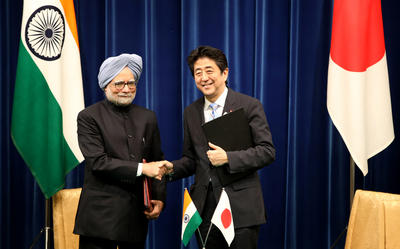Instead, it reaffirmed and reinforced the two countries’ ‘global and strategic partnership’ and set some new initiatives and goals for the near future.
These goals include more aid to Delhi for the purpose of large infrastructure projects, the possibility of concluding a civil nuclear technology agreement and even sales of Japanese arms. These are no small developments given Japan’s past neglect of India and its strident condemnation of India’s nuclear testing in 1998, followed by sanctions including via official aid.
India–Japan relations have come a long way in the last decade. India has emerged as the single largest recipient of Japanese aid; the two have declared themselves as global and strategic partners; they have signed a Joint Declaration on Security Cooperation in 2008; and they now even conduct a two-plus-two dialogue which brings together top military and defence officials in the only such arrangement India has with any country. There is a Japan–India Maritime Exercise (JIMEX) in place. Many other ministerial-level dialogues are held in a range of areas from commerce and industry to maritime security and energy matters. And the list is growing.
While bilateral trade and investment still remain at a relatively low level, their security and defence cooperation ties are strengthening and expanding as their strategic thinking converges. For example, both are concerned about the safety and security of the sea lanes and believe in a peaceful and stable Indo-Pacific. Japan sees India as a great balancer against China’s rising influence and a trustworthy partner in the filling of the strategic vacuum created by declining US military resources, especially in the Indian Ocean area.
The bilateral relationship is increasingly becoming a securitised one in which Japan seeks in India a security and strategic partner — a role India is happy to play. India in turn wants Japan’s high-end technology, private investment and greater access to the Japanese market — concessions which Tokyo is now willing to consider.
The Joint Statement directs officials of both countries to accelerate negotiations on civil nuclear cooperation, stalled in the wake of the 2011 Fukushima nuclear fallout, towards an early conclusion. It might even be finalised as early as within this year if Abe is able to secure a decent majority for his ruling party in the July upper house elections.
Successfully concluding a nuclear agreement with Japan will be Singh’s greatest coup on the nuclear issue. He has already already accomplished significant achievements this area, including Australia’s lifting of its ban on nuclear exports to India. Singh would like to see this Japan outcome achieved sooner rather than later since he is unlikely to continue in his position after India’s 2014 general elections.
The other key development is the possibility of selling Japanese US-2 amphibian aircraft, used by Japan’s Maritime Self Defence Force. The two prime ministers have agreed to establish a Joint Working Group to explore modality for such sales. If the deal goes ahead, it will signify a new era in India–Japan relations, especially since Japan has only recently lifted its five-decades-old ban on arms exports. This will also be Japan’s first sale of a finished military product.
India is at the centre of Prime Minister Abe’s security thinking. He has now articulated a new security diamond consisting of India, Japan, Australia and the United Sates — a reincarnation of his failed first-term quadrilateral security framework. Whether this new architecture comes to fruition is irrelevant — what is amply clear is that Japan sees India as a key security partner bilaterally and multilaterally.
While few commentaries on Singh’s visit appeared in the international media, China has reacted sharply. Comments have ranged from Japan ‘wooing’ India to contain China, to depicting Japanese politicians as ‘petty burglars’. The Global Times even warned that ‘India gets close to Japan at its own peril’, making its point with a cartoon depicting China as being heavier than the combined weight of Japan and India.
China clearly feels unsettled with these new developments, particularly given Japan’s generous economic and security gifts and India’s positive response to Japan’s strategic thinking. Yet China needs to think long and hard about its own actions and behaviour in the region and reflect seriously on what has changed its regional position.
In the 1980s when India sought Japan’s technology, capital and aid for its economic development, Japan was uninterested because it was singularly focused on China. China became Japan’s number-one aid recipient for infrastructure projects, investment from Japan flowed freely, and bilateral trade expanded exponentially — it seemed Japan and China had entered a perpetual period of partnership and friendship.
Is it the case now that China has unintentionally thrown India and Japan in each other’s lap? A Japan–India partnership makes sense as India becomes increasingly concerned about the implications of China’s assertiveness and Japan feels ever more threatened by what it regards as China’s aggression.
Purnendra Jain is Professor in Asian Studies at the University of Adelaide.


One of its actions China may ‘need to think hard and long about’ is Premier Li’s making India the destination for his first overseas visit. This was hardly a gesture intended to throw ‘India and Japan in each other’s lap’. President Xi had previously given Moscow the honour of being his first foreign port of call. The red carpet in New Delhi had barely been rolled up again before Manmohan Singh set off to Tokyo, thereby administering a slap in the face to his Chinese counterpart. No wonder the Chinese reacted sharply. One woould like to know what the point of Singh’s hurry was. Even if the octogenarian Singh steps down or is defeated next year, allowing a longer period to elapse after Li’s departure would have been made for more effective diplomacy.